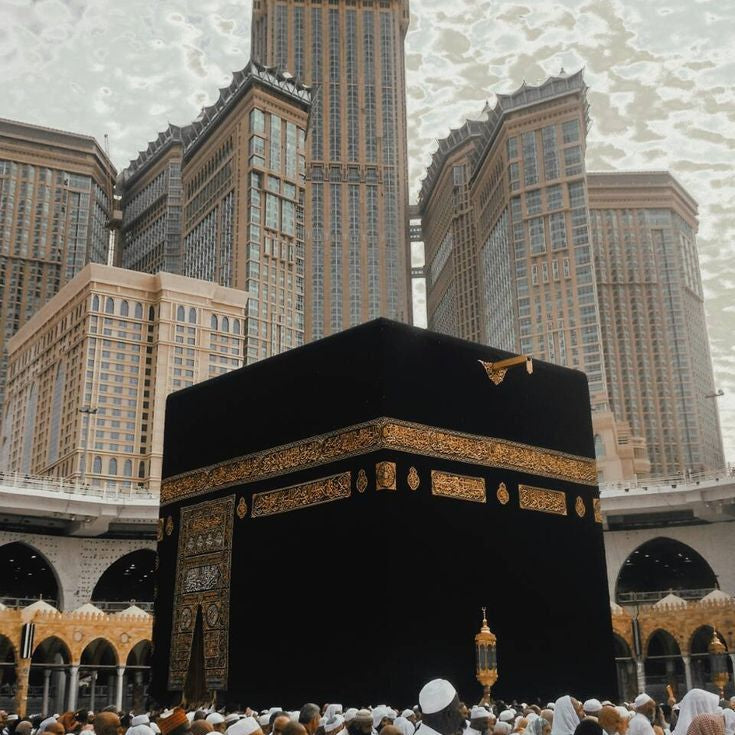Origin of Hajj
Hajj, the pilgrimage to the Kaaba, the "House of Allah," in the sacred city of Mecca in Saudi Arabia, is a mandatory religious duty for Muslims that must be carried out at least once in their lifetime. It is one of the Five Pillars of Islam, alongside Shahadah (the oath that one believes there is no god but Allah), salat (prayer), zakat (almsgiving), and sawm (fasting during Ramadan).
Nowadays, approximately 3 million Muslims gather to partake in this sacred pilgrimage each year, which is far more than a physical endeavor. It is an opportunity to deepen their spiritual connection with their religion and heritage, enhancing their spiritual well-being and pleasing the Lord by fulfilling this essential pillar of their faith. Why don't we discuss where Hajj originated from?
According to Islamic tradition, the concept of “Hajj” dates back centuries to the time of Prophet Ibrahim (AS), when Allah (SWT) ordained him to build the Kaaba in Mecca as a house of worship, symbolizing the monotheistic belief in one God. This command of Allah to Prophet Ibrahim (AS) is mentioned multiple times in the Quran,
“And ˹remember˺ when We assigned to Abraham the site of the House, ˹saying,˺ “Do not associate anything with Me ˹in worship˺ and purify My House for those who circle ˹the Ka’bah˺, stand ˹in prayer˺, and bow and prostrate themselves.” [22:26]
Then in Surah Baqarah, a series of 6 verses further speak on the same topic in a tad bit more detail, and mention how Prophet Ibrahim (AS) and his son, Prophet Ismail (AS) laid the foundation stones of the Kaaba,
“And [mention] when Abraham was raising the foundations of the House and [with him] Ishmael, [saying], "Our Lord, accept [this] from us. Indeed You are the Hearing, the Knowing.” [2:127]
Aside from his involvement in constructing the Kaaba, the life of Prophet Ibrahim (AS) is deeply intertwined with the story of Hajj. He is represented as a figure revered in Islam for his unwavering faith and submission to God's will.
According to Islamic history, Prophet Ibrahim (AS) was commanded by Allah(SWT) to go to Mecca along with his wife (Hajar) and his newborn son (Prophet Ismail (AS)). At that time Mecca was nothing more than a piece of barren desert and it is at that place where they faced a real test of faith.
When her son started to cry of thirst, as an act of desperation, Hazrat Hagar (RA) ran 7 times between the small hills of Safa and Marwa. Allah(SWT) fulfilled Hazrat Hagar (RA)'s plea by revealing the ZamZam well. This miraculous blessing continues to flow to this day and countless Muslims are able to indulge in savoring a taste of the holy water, while the act of running between the 2 hills went on to be named “Saee” that Muslims participate in during Hajj or Umrah.
The basic concept that can be deduced is their unwavering faith in Allah (SWT), which has become a fundamental aspect of the Hajj, symbolizing the struggles and perseverance demonstrated during this sacred journey.
As time went on, people started to become misguided once again and the concept of monotheism became taboo, replaced with idol worship. The site of Kaaba was destroyed and later surrounded by hundreds of idol figures. However, in 630 CE, when the Prophet Muhammad (PBUH) conquered Mecca along with his companions, he destroyed all idol figurines and cleaned the Kaaba by restoring its status as a house of monotheistic worship. In 632 CE, the Prophet (PBUH) cemented the concept of Hajj and highlighted the rituals of Hajj as we follow today. Leading by example, the Prophet (PBUH) himself participated in the quest which was later known as the “Farewell Pilgrimage”, as this was the year the Prophet passed away.
By the end of the Farewell pilgrimage, the Prophet delivered a sermon, in which he encapsulated the essence of Islamic teaching of justice, compassion and faith, to motivate the Muslims towards a life of righteousness. The Prophet’s instructions during this Hajj became the definitive framework for the rituals and practices associated with Hajj.
Each ritual of Hajj, is representative of the courageous acts of Prophet Ibrahim (AS), Hazrat Hagar (RA), and Prophet Ismail (AS). These moments rank so significant that Allah (SWT) made it obligatory for Muslims to reenact and pay tribute to their sacrifice.
When we circumambulate the Kaaba, it reflects the monotheistic worship initiated by Prophet Ibrahim (AS). As mentioned previously, the practice of Saee honors Hazrat Hagar (RA)’s search for water for her thirsty child.
Evidently, the concept of Hajj holds an immense amount of religious significance, making us responsible for educating fellow Muslims on its procedure and origins. If you are a parent, this duty lies far heavier on your shoulders as compared to others.

Enlightening children about such a weighted concept must be tricky, almost intimidating. To help make the process easier, we have taken the initiative to develop an interactive DEENIN Kids' Hajj Adventure Jigsaw Puzzle for young ones. Once assembled, the 48-piece puzzle comes together to showcase a colorful depiction of the pilgrimage's key stages, symbols, and rites. It helps children easily visualize and understand the process of Hajj, allowing you to engage with them and explain the significance and backstory behind each step of this sacred journey.
Not only is it perfect for your little ones but it also makes a delightful gift as a valuable addition to a child's Islamic education.
References:
- https://legacy.quran.com/2/121-127
- https://quran.com/en/al-hajj/26
- https://en.wikipedia.org/wiki/Kaaba
- https://en.wikipedia.org/wiki/History_of_the_Hajj
- https://www.khanacademy.org/humanities/ap-art-history/introduction-cultures-religions-apah/islam-apah/a/hajj#:~:text=Muslims%20believe%20that%20the%20rituals,year%20from%20across%20the%20world.

Share:
Fun Ways to Teach Kids About Islam
Islamic Architecture: A Timeless Journey